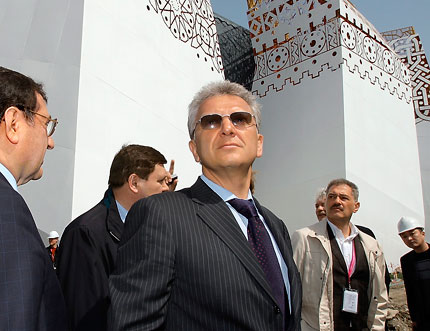World Expo to display a friendly, open, generous Russia: official
Prior to the opening of the Shanghai Expo, Russia's Expo commission general told Xinhua that people would see a developing, open, friendly and generous Russia at the world's grand gathering.
Vladimir Strashko, also the Vice President of Russian Chamber of Commerce and Industry, said the Russian pavilion, with a total area of 6,000 square meters, is one of the biggest exhibition sites at the World Expo.
For the first time in 30 years, said Strashko, Russia is spending some 1.1 billion rubles (around 37 million U.S. dollars) to construct its expo pavilion rather than renting one from the host country.
 |
|
Victor B. Khristenko, Minister of Industry and Trade in the Russian Federation, visits the Russia Pavilion at Shanghai Expo site. He said the pavilion would create a fairy tale world to introduce Russian traditional culture and advanced technologies to children, the builders of future cities. |
Little Dunno comes to China
The pavilion, comprising 12 towers in different shapes, will serve as conference and exhibition halls, gift shops and dining rooms, he said, where visitors can buy souvenirs and enjoy Russian food.
"We hope the architecture style, interior artistic design and the arrangements of exhibits of the pavilion could form an integrated whole," Strashko told Xinhua in a recent interview.
The first floor of the pavilion will present a fairy tale world, he said. Some nine pictures, which depicted future cities in children's eyes, have been chosen from a children drawing contest held in Russia, he said.
Based on these drawings, sculptures of a future ideal city were made for the expo, he said, adding that these little painters will also be invited to the expo to draw for the visitors.
The idea was inspired by famed Russian children's literature writer Nikolay Nosov who once said "the best cities should be those liked most by the children," Strashko explained.
Before the expo, the little hero Dunno (Neznaika) created by Nosov will also come to China for his newest adventure.
In Nosov's 1954 fairy story "The Adventures of Dunno and His Friends," little Dunno makes a hot balloon trip around the globe, which Strashko said had inspired the design of the Russian pavilion.
While this time in Shanghai, Dunno will present via multimedia screen five priorities of Russia's innovative economy: energy efficiency, nuclear technology, aerospace, medical science and strategic information technology.
Cutting edge technologies for better city
Speaking of exhibits, Strashko said the pavilion will set two permanent and one rotating exhibition halls, in order to showcase cultural and historical inheritance from various regions of the country.
One feature of the exhibits will be new technologies to improve modern urban life, said Strashko, such as tidal power stations and new nuclear technologies in the energy and ecological sectors.
In particular, some breakthroughs in Russian tidal power stations will be displayed in China, he added.
Another cutting edge scientific achievement is a new type of floating nuclear power stations, which is of special significance to coastal cities.
In addition, eight new scientific projects including new fuel, nanotechnology in construction materials, industrialized manufacture of pavement materials and nanotechnology in energy-efficient lighting, are also among the exhibits, some 90-95 percent of which would debut at the expo, said Strashko.
The official meanwhile promised that ordinary people would easily understand the interpretations of these technologies, since Russia, like other countries, also is dedicated to ways of better city life and better environment.
Displaying a new Russia to the world
"Through the World Expo, we would like to show the world the true image of a new Russia that has undergone huge transformations in economy, culture and society," said Strashko.
Strashko also believed that the exhibition would definitely fascinate visitors as well as experts, and strongly boost connections and cooperation between China and Russia in all-round fields.
The official also told Xinhua that Russia plans to further use its exhibition pavilion as a cultural center for China and Russia, after the expo is closed.
The organizers might decide how to use the pavilion at best after the exhibition is concluded. For instance, he said, the first floor might be used as office, while the second floor might be open to the public.
Part of the inner facilities might also be transferred to the Black Sea city of Sochi for exhibition during the 2014 Winter Olympics.
Strashko pledged that the Russian pavilion will duly open before the 2010 World Expo kicks off on May 1.
(Xinhua March 22, 2010)
 0
0 







Go to Forum >>0 Comments